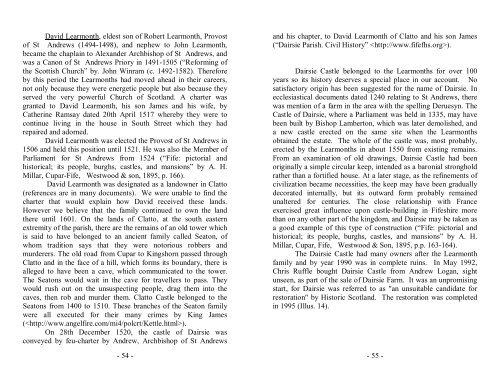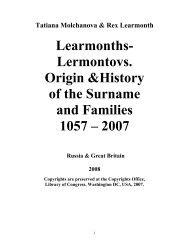LEARMONTH-LERMONTOV. A HYISTORY OF THE NAME AND FAMILIES
By Tatiana Molchanova and Rex Learmonth, 2011
By Tatiana Molchanova and Rex Learmonth, 2011
- No tags were found...
You also want an ePaper? Increase the reach of your titles
YUMPU automatically turns print PDFs into web optimized ePapers that Google loves.
David Learmonth, eldest son of Robert Learmonth, Provost<br />
of St Andrews (1494-1498), and nephew to John Learmonth,<br />
became the chaplain to Alexander Archbishop of St Andrews, and<br />
was a Canon of St Andrews Priory in 1491-1505 (“Reforming of<br />
the Scottish Church” by. John Winram (c. 1492-1582). Therefore<br />
by this period the Learmonths had moved ahead in their careers,<br />
not only because they were energetic people but also because they<br />
served the very powerful Church of Scotland. A charter was<br />
granted to David Learmonth, his son James and his wife, by<br />
Catherine Ramsay dated 20th April 1517 whereby they were to<br />
continue living in the house in South Street which they had<br />
repaired and adorned.<br />
David Learmonth was elected the Provost of St Andrews in<br />
1506 and held this position until 1521. He was also the Member of<br />
Parliament for St Andrews from 1524 (“Fife: pictorial and<br />
historical; its people, burghs, castles, and mansions” by A. H.<br />
Millar, Cupar-Fife, Westwood & son, 1895, p. 166).<br />
David Learmonth was designated as a landowner in Clatto<br />
(references are in many documents). We were unable to find the<br />
charter that would explain how David received these lands.<br />
However we believe that the family continued to own the land<br />
there until 1601. On the lands of Clatto, at the south eastern<br />
extremity of the parish, there are the remains of an old tower which<br />
is said to have belonged to an ancient family called Seaton, of<br />
whom tradition says that they were notorious robbers and<br />
murderers. The old road from Cupar to Kingshorn passed through<br />
Clatto and in the face of a hill, which forms its boundary, there is<br />
alleged to have been a cave, which communicated to the tower.<br />
The Seatons would wait in the cave for travellers to pass. They<br />
would rush out on the unsuspecting people, drag them into the<br />
caves, then rob and murder them. Clatto Castle belonged to the<br />
Seatons from 1400 to 1510. These branches of the Seaton family<br />
were all executed for their many crimes by King James<br />
().<br />
On 28th December 1520, the castle of Dairsie was<br />
conveyed by feu-charter by Andrew, Archbishop of St Andrews<br />
- 54 -<br />
and his chapter, to David Learmonth of Clatto and his son James<br />
(“Dairsie Parish. Civil History” ).<br />
Dairsie Castle belonged to the Learmonths for over 100<br />
years so its history deserves a special place in our account. No<br />
satisfactory origin has been suggested for the name of Dairsie. In<br />
ecclesiastical documents dated 1240 relating to St Andrews, there<br />
was mention of a farm in the area with the spelling Deruesyn. The<br />
Castle of Dairsie, where a Parliament was held in 1335, may have<br />
been built by Bishop Lamberton, which was later demolished, and<br />
a new castle erected on the same site when the Learmonths<br />
obtained the estate. The whole of the castle was, most probably,<br />
erected by the Learmonths in about 1550 from existing remains.<br />
From an examination of old drawings, Dairsie Castle had been<br />
originally a simple circular keep, intended as a baronial stronghold<br />
rather than a fortified house. At a later stage, as the refinements of<br />
civilization became necessities, the keep may have been gradually<br />
decorated internally, but its outward form probably remained<br />
unaltered for centuries. The close relationship with France<br />
exercised great influence upon castle-building in Fifeshire more<br />
than on any other part of the kingdom, and Dairsie may be taken as<br />
a good example of this type of construction (“Fife: pictorial and<br />
historical; its people, burghs, castles, and mansions” by A. H.<br />
Millar, Cupar, Fife, Westwood & Son, 1895, p.p. 163-164).<br />
The Dairsie Castle had many owners after the Learmonth<br />
family and by year 1990 was in complete ruins. In May 1992,<br />
Chris Ruffle bought Dairsie Castle from Andrew Logan, sight<br />
unseen, as part of the sale of Dairsie Farm. It was an unpromising<br />
start, for Dairsie was referred to as "an unsuitable candidate for<br />
restoration" by Historic Scotland. The restoration was completed<br />
in 1995 (Illus. 14).<br />
- 55 -






